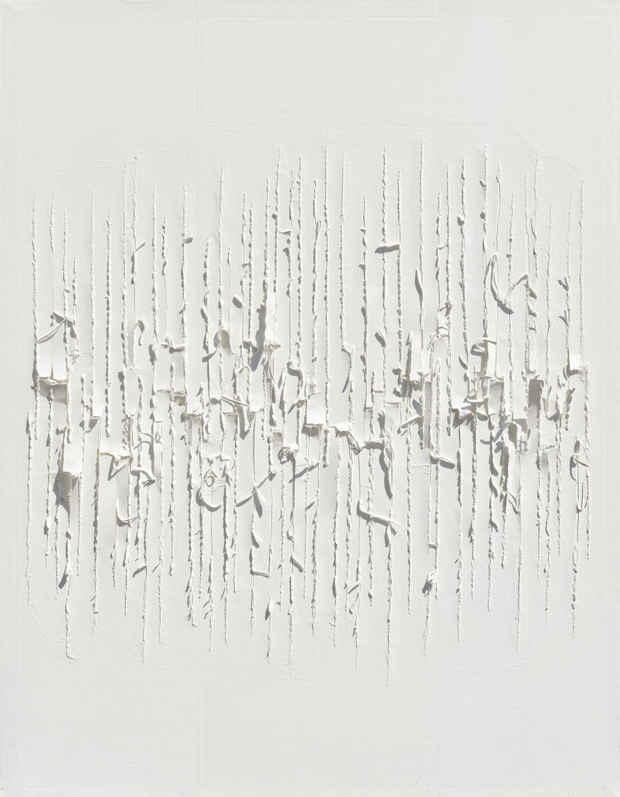Kwon Young-Woo “Gestures in Hanji”
Tina Kim Gallery

This event has ended.
The range of processes from ripping to creating penetrating holes… is not different from drawing lines and dots with a brush. Both contain the performance of the artist’s volition.
-Kwon Young-Woo
Tina Kim Gallery presents Gestures in Hanji, a solo exhibition of Kwon Young-Woo (1926-2013) who was a leading artist of the Dansaekhwa movement. This is the artist’s first exhibition with the gallery featuring Kwon’s signature works on paper from the 1970s to 2000s. The exhibition traces the trajectory of Kwon’s work throughout his artistic career: his early 1970’s works showcasing his method of cutting and tearing sediment-like layers of hanji (traditional Korean mulberry paper); his Paris period (1978-1989), in which he first introduced pools of color into his compositions; his return to Korea in 1989, which prompted his singular attention toward overlapping lines of color; and finally, his return to the two-dimensional plane in the early 2000’s with misty-white geometric forms over bare canvas backgrounds.
One of the few Dansaekhwa artists trained in Oriental ink painting, Kwon instantiated a new relationship between paper and its manipulation that touched on both the practices of ink painting and hanji in the East and postwar abstraction in the West. Employing traditional material approaches in service of a modernist vision, the artist rejected medium specificity in favor of highlighting the sculptural and architectural possibilities of paper. From his earliest work onward, Kwon saw paper as both surface and structure. He fluctuated between techniques of collage and décollage, often within the same work: layering, pressing, and sculpting it and at other times, ripping, puncturing, and saturating it. Oftentimes using his fingernails to manually scratch and tear the surface of paper from behind, his visceral treatment of paper became a driving force of his practice.
Though his early work centered the complex minutiae of white tones present in hanji, Kwon’s experimentation with the paper as material and method evolved in the late 1970s once he began using monochrome tonal ink and shadows to create optical effects. Creating hair-thin incisions that often dredged into coarse tears in the paper, he would apply ink to the back, allowing it to bleed down and absorb around and through the lacerations. After his return to Korea in 1989, Kwon began to fixate on color and tone rather than structural manipulation. The artist introduced thick lines of blue, brown, and yellow pigments into his works that were made by mixing Western gouache with meok (Chinese ink). This process was a continuation of Kwon’s life-long investigation of chance creations and the collapse of hemispheric divisions. In the 2000s, Kwon incorporated geometric shapes by overlapping thin layers of almost translucent hanji on wooden panels, revealing the complexity of the white paper.
Kwon’s work avoids the binary characteristics defining “Eastern” and “Western” art as much as it does the structural limitations of medium specificity. In using unconventional tools and his bare hands to experiment with the materiality of hanji, Kwon conjured a pioneering abstract vocabulary in the two-dimensional frame. In his devotion to material, the singular artist was able to slip, sublimely, into a mode of making unconcerned with vogue, even as it rendered visible the ever-flowing mutability of tradition.
Kwon stated, “I do not know when the conclusion of my practice may be, but what is important to me is to keep going forward one step at a time, with commitment, and to do it continuously.”
Kwon Young-Woo (1926-2013) matriculated at Seoul National University in 1946 in the first class of the College of Fine Arts and studied Oriental painting. He received his MFA, also from Seoul National University, in 1957. He taught at Chung-Ang University from 1964 to 1978 before moving to Paris, where he spent about ten years fully devoted to his studio practice. He has had solo exhibitions in major venues including Blum & Poe, New York (2016); Kukje Gallery, Seoul (2015); Seoul Museum of Art (2007); National Museum of Modern and Contemporary Art, Korea (1998); Ho-Am Art Museum, Seoul (1990); and Jacques Massol Gallery, Paris (1976). His work has also been featured in international biennials and group exhibitions, such as Korean Abstract Art: Kim Whanki and Dansaekhwa, Powerlong Museum, Shanghai (2018-19); When Process Becomes Form: Dansaekhwa and Korean Abstraction, Boghossian Foundation, Brussels (2016); the official collateral exhibition of the 56th Venice Biennale Dansaekhwa, Venice Biennale, Venice (2015); Five Korean Artists, Five Kinds of White at Tokyo Gallery (1975); the 12th Biennale de São Paulo (1973); and the 8th Tokyo Biennale (1965). His works are included in the collections of art institutions including the MMCA, Korea; Seoul Museum of Art, Korea; Leeum, Samsung Museum of Art, Seoul, Korea; the British Museum, London, UK; and Centre Pompidou, Paris, France.
Media
Schedule
from March 24, 2022 to April 30, 2022